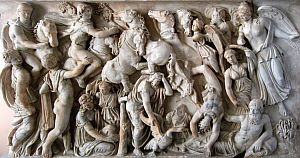
|
|
Ancient Greek
|
|



|
|
Hydra
Ian Ridpath tells us two stories about the Hydra:
|

|

Continuing Ian Ridpath quote:
 "A second legend associates the water-snake with the constellations of the Crow (Corvus) and the Cup (Crater) that lie on its back. In this story, the crow was sent by Apollo to fetch water in the bowl, but loitered to eat figs from a tree. When the crow eventually returned to Apollo it blamed the water-snake for blocking the spring. But Apollo knew that the crow was lying, and punished the bird by placing him in the sky, where the water-snake eternally prevents him from drinking out of the bowl."  Source:Ian Ridpath |
 Hydra, Corvus and Crater in Urania's_Mirror (1824)
Hydra, Corvus and Crater in Urania's_Mirror (1824)Source: Wikipedia |



|
|
Leo
Greek mythology adopted the visualization of the constellation as a lion and identified
Leo as the Nemean Lion which was killed by Heracles
during the first of his twelve labors.
|
 Heracles and the Nemean Lion
Heracles and the Nemean LionMosaic in Paphos, Cypriot stamp Source: placeresgriegos.blogspot.com
|



|
|
Libra
At the end of the Babylonian era, the stars of Libra became the claws of neigboring Scorpius. One reason for the transition can be the similarity of the
Babylonian zib.ba.an.na with the word zubānā, which in Arabic and other Semitic languages
means "scorpion's claws."
|

|



|
|
Lyra
Ian Ridpath tells us that the first lyre ever made, was "... invented by
Hermes, the son of Zeus and
Maia (one of the Pleiades). Hermes
fashioned the lyre from the shell of a tortoise that he found browsing outside his cave on Mount Cyllene in Arcadia. Hermes cleaned out the shell,
pierced its rim and tied across it seven strings of cow gut, the same as the number of the Pleiades.
|

|

Wikipedia tells us, that "...Orpheus's music was said to be so great that even inanimate
objects such as trees, streams, and rocks could be charmed. Joining Jason and the Argonauts, his
music was able to quell the voices of the dangerous Sirens, who sang tempting songs to the Argonauts.
 At one point, Orpheus married Eurydice, a nymph. While fleeing from an attack by Aristaeus, she stepped on a snake that bit her, killing her. To reclaim her, Orpheus entered the Underworld, where the music from his lyre charmed Hades.  Hades relented and let Orpheus bring Eurydice back, on the condition that he never once look back until outside. Unfortunately, near the very end, Orpheus faltered and looked back, causing Eurydice to be left in the Underworld forever."  Source:Wikipedia |
 Orpheus surrounded by animals
Orpheus surrounded by animalsAncient Roman floor mosaic Source: Wikipedia
|



|
|
Milky Way
Γαλαξίας (Galaxias), the Greek name for the Milky Way is derived from γάλα (gala), the Greek word for milk. In
Greek mythology, there are two legends about how the Milky Way was created. Both stories are centered
around Heracles, a mortal son of Zeus, and
Hera, Zeus' wife.
|
 The Origin of the Milky Way; Tintoretto
The Origin of the Milky Way; Tintorettoca. 1575–1580; Source: Wikipedia |
In a different version, also told by Wikipedia,
Heracles was abandoned in the woods by his mortal parents,
Amphitryon and Alcmene.
His father Zeus sent Athena, goddess of wisdom,
to retrieve him. Athena decided to take him to Hera who agreed to suckle Heracles. As Heracles drinks
the milk, he bites down, and Hera pushes him away in pain. The milk that squirts out forms the Milky Way.
 The first scholars to speculate that the Milky Way consisted of stars too far away to be individually distinguished were Greek philosophers Anaxagoras (ca. 500–428 BC) and Democritus (460–370 BC).  Source:Wikipedia |

The Great Rift is a group of dark dust clouds, significantly obscuring
parts of the Milky Way for observers on Earth.
 In Greek mythology, the Great Rift is sometimes seen as the path of devastation left by Phaeton, who tried to guide the chariot of of his father, the Sun god Helios across the sky. Phaeton lost control over the chariot, wreaking havoc before being struck down by a Zeus' lightning bolt. The northern Coalsack Nebula, which marks one end of the Great Rift is seen as the end of Phaeton's trail of devastation. |
 The fall of Phaeton; Wikipedia
The fall of Phaeton; Wikipedia
|
In another Greek myth, the trail carved by Phaeton is seen as the constellation Eridanus.
 Sources: Wikipedia, oneminuteastronomer.com |


 |
Back to Part 4 | Forward to Part 6 |
 |


|
Back to Star Lore |
Back to Mythology |

Back to Greek Myth |
Back to Space Page |
Back to English |
 Back to Start Page |